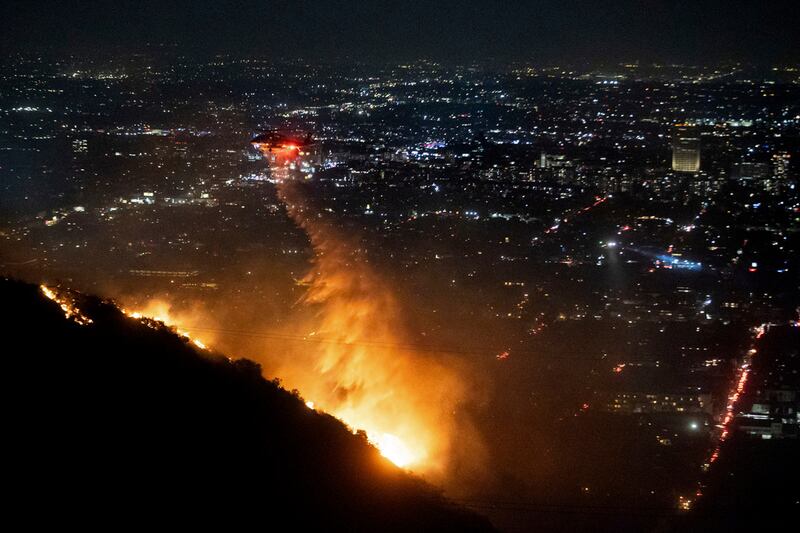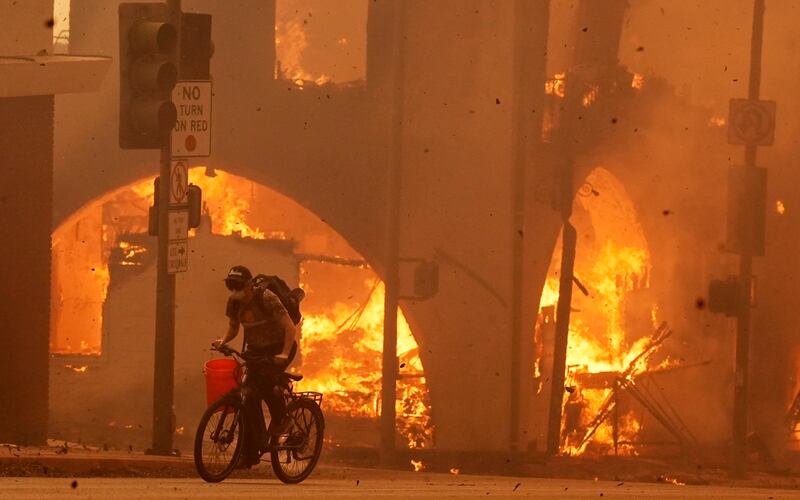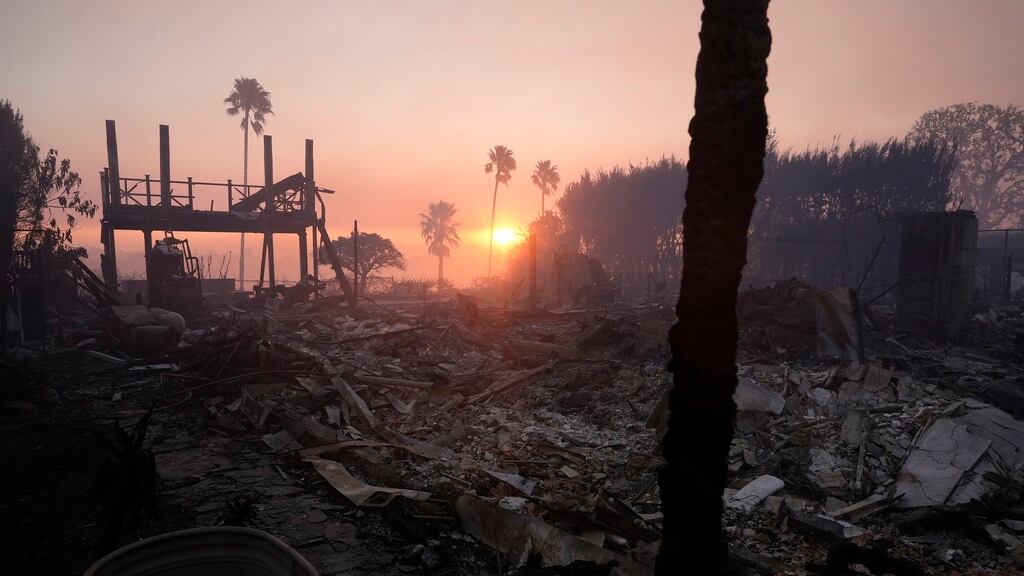LOS ANGELES (AP) — Firefighters began to make progress in the fight against the deadly and devastating fires in the Los Angeles area from the early hours of Thursday, especially as fierce winds that have fueled the flames are expected to decrease.
The firefighters managed to control a significant threat that erupted on Wednesday night in the Hollywood Hills, approaching the heart of the city, the hub of the entertainment industry. By morning, authorities lifted an evacuation order for the area.
PUBLICIDAD
The forecasted weather could provide an opportunity for firefighters to make progress in controlling the fires, which have caused the death of five people, devastated communities from the Pacific coast to Pasadena, and led to thousands of people frantically fleeing their homes.
During the night, the fire embers illuminated the Santa Monica Mountains over Pacific Palisades. The houses were still burning, but unlike Tuesday night, when a fierce wind blew the embers sideways and fueled new outbreaks, the sparks were mostly moving upwards.

"The damages from the Palisades fire are already being assessed. In the preliminary reports, it is estimated that the damaged or destroyed structures amount to several thousand," said Los Angeles Fire Chief Kristin Crowley on Thursday morning at a press conference. "We can say that the Palisades fire is one of the most destructive natural disasters in the history of Los Angeles."
At least 180,000 residents are under evacuation orders in all county fires, authorities said.
The flames from the Sunset fire, in the Hollywood Hills, alerted the densely populated neighborhoods. Just 1.6 kilometers (one mile) away, the streets surrounding the Hollywood Walk of Fame, Grauman's Chinese Theatre, and Madame Tussauds museum were filled with people, and onlookers used their phones to record videos of the hills on fire.
Captain Erik Scott, of the Los Angeles Fire Department, said they were able to keep the fire under control because "we attacked it hard and fast, and today Mother Nature was a little kinder to us than yesterday."
The winds fuel the fires.
On Wednesday, hurricane-force winds sent embers flying through the air, igniting one apple after another in the coastal neighborhood of Pacific Palisades, as well as in Altadena, a community near Pasadena. Aircraft had to stay grounded for a while due to the winds, making it difficult to extinguish the fire.
Almost 2,000 homes, businesses, and other structures have been destroyed in these fires—known as the Palisades and Eaton fires—and the number is expected to increase. The five deaths reported so far were caused by the Eaton fire near Pasadena.
More than 100,000 people are under evacuation orders, and the fires have consumed nearly 45 square miles, which is almost the total surface area of the city of San Francisco. The Palisades fire is already the most destructive in the history of Los Angeles.
José Velásquez was spraying his family home in Altadena with water as embers fell on the roof. He managed to save his home, which also houses the family churro business. Many of his neighbors were at work when they lost their homes.
"So we had to call some people and we received messages asking if their house was still standing," he said. "We had to tell them no."

In Pasadena, the fire chief, Chad Augustin, said that the municipal water system was overloaded and power outages were causing more obstacles, but even without those problems, they would not have been able to stop the fire due to the intense winds fanning the flames.
"Those erratic gusts of wind were throwing embers several miles ahead of the fire," he explained.
However, questions arose about why some fire hydrants ran dry and what caused the water system to collapse when it was most needed.
The extent of the destruction was clearly seen when comparing satellite images before and after the fire.
About 250 homes in the Altadena neighborhood, dotted with the green treetops of lush trees and aquamarine-colored pools, were reduced to rubble. Only a few homes remained standing, and some were still on fire, according to images from Maxar Technologies. In a row of about 70 homes side by side overlooking the Pacific Ocean in Malibu, fewer than 10 appeared to have remained intact.
In Pacific Palisades, an area located on a hillside along the coast where many celebrity homes are located, block after block of California Mission-style houses and bungalows were reduced to charred remains. An ornamental iron fence surrounded the smoldering frame of a house. The pools were covered in soot and sports cars slumped on melted tires.
The rapid advance of the flames left little time to escape.
The main fires grew rapidly in very different areas that, however, had two things in common: densely populated streets with homes in sites full of vegetation and prone to burning in dry conditions.
The flames advanced so quickly that many people barely had time to escape; some abandoned their vehicles and fled on foot. The police officers took refuge inside their patrol cars, and the residents of a nursing home were transported in wheelchairs and hospital beds down a street to a safer place.
Actors are losing their homes
The flames advanced towards neighborhoods where the rich and famous of California live.
Mandy Moore, Cary Elwes, and Paris Hilton were some of the celebrities who lost their homes. Billy Crystal and his wife Janice lost the house they had lived in for 45 years due to the Palisades fire.
"We raised our children and grandchildren here. Every inch of our home was filled with love. Beautiful memories that cannot be taken away," the Crystals wrote in a statement.
In Palisades Village, the public library, two large grocery stores, a couple of banks, and several boutiques were destroyed.
"It's really strange to return to a place that no longer exists," said Dylan Vincent, who returned to the neighborhood to retrieve some items and saw that his elementary school had been destroyed.
Higher temperatures and less rain extend the fire season
The fire season in California has started earlier and will end later due to increased temperatures and decreased rainfall, all caused by climate change, according to recent data. The rains that usually mark the end of this season are being delayed, which means fires can burn during the winter months, the Western Fire Chiefs Association said.
The dry winds, including the famous Santa Ana winds, have contributed to warmer temperatures than usual in Southern California, which has not seen more than 0.1 inches of rain since early May.
The winds increased to 80 mph on Wednesday, according to reports received by the National Weather Service. The favorable conditions for wildfires could last until Friday, but it was expected that wind speeds would be lower on Thursday.
Iconic places are closed and productions are suspended
President Joe Biden signed a federal emergency declaration after visiting a fire station in Santa Monica for a briefing with Governor Gavin Newsom, who mobilized National Guard troops to assist.
Several Hollywood studios suspended their productions, and Universal Studios closed its theme park.
Several iconic places in Southern California suffered significant damage, such as the Reel Inn in Malibu, a seafood restaurant. Its owner, Teddy Leonard, and her husband, are hoping to rebuild it.
“When you look at the big picture of things, as long as your family is well and everyone is alive, everything else is a bonus, right?” he said.
